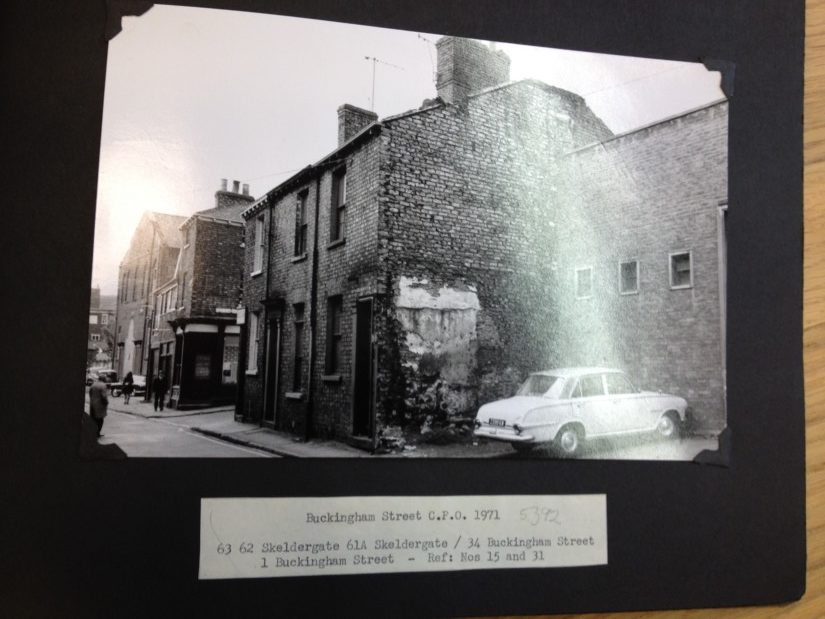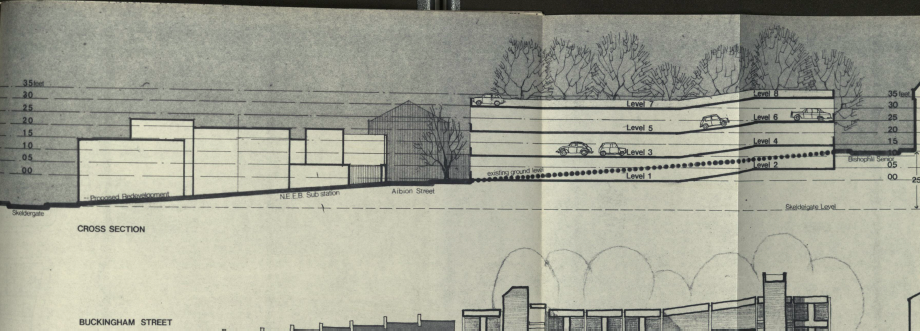
2016
Early and bright. Routines unfold. The towel. The stairs. The shower. Then as the hand slides round, gaining speed towards the precise moment of necessary exit. Then the rush. Teeth cleaning. The keys. Phone. Bag. Out the house. Notice three more houses on the street are for sale. And one more now for let. 17 minutes walk to the station down Cinder Lane.
The changing same. The flowers in a beautiful garden. The broken pattern in the pavement. The hollow sound of my feet on the foot bridge. The back passage between Holgate and Leeman Road once walled, once falling over, now more pragmatically fenced creating a visual connection between the railway maintenance sheds and the trickle of commuters heading for trains to offices in West Yorkshire. Then down the metal steps, across the car park. Nod to the attendant who ensures parking payment is given but also tidies, picks up litter, says hello to the regulars that park and walk across his patch. 4 minutes until the train leaves.
Practiced ticket buying. Muscle memory of the spatial choices needed to get a day return to Leeds. On the platform in time. Early enough (and late enough will do too) to get a seat. The odd public-private space of a commuting train carriage. Mutually respective of need to sleep, eat breakfast, apply make up, of laptop. The many working lives that compel travel and ‘being flexible’, all of us have the ability to focus anywhere and the need to use those 22 minutes to Leeds in some way. I work too and also watch the ripples of the seasons, catch a view of a favourite village, spire, field, sometimes a deer, usually rabbits. Each acting as a kind of visual echo of my childhood, of fields, and sunrise, and mists. My rural past in my present within and between two urban spaces. Then Leeds starts to emerges slowly between the fields and then faster as we enter the station. Happy to not yet entirely have to speak or to listen to others, before an equally happy day at the University of much of both.
Arriving back into York station. Busy train, though it is past commuters most popular home time. Seat on the aisle. Managed to work until after the final signal into the station, another email done and some sense of satisfaction. My day measured out in cups of tea and things struck off scrappy to do lists as well as good conversations and the constant flows of ideas and glimpses of possibilities. The working day over as the train stops. Rush. Laptop in cover. Then in bag. Grab scarf.
My bag is heavy with stuff bought at Marks and Spencer – at a price – at Leeds Station. The penalty of disorganization. The bustle of many people getting off a train and not knowing how to exit the station. But I become free as I head back out the back of the station with those heading to their cars and then the many fewer heading to Holgate or Acomb. The same path. Sometimes here, just before the footbridge over the tracks, I suddenly smell the earth on a damp yet warm day or fragrance of pollen. Over the bridge, past the train spotters. Then back way past the allotments [and fleetingly feel bad about the weeds that are probably growing in mine and my sisters allottment], the bowling club playing in whites, smiling at the dog walkers, down between the terraces and notice the beautiful purple flowery weeds growing in the crevices Victorian wall, never repointed.
Back through the door. Bread and salad plus expensive not-that-great cheese. Discuss the day – or we choose not to. The news. And then the sofa, bit knackered, but watch a television programme and a fictional world to which we have long committed and much discuss: beautifully made, complex, compelling, enriching. Then messing around, familiar jokes, always and every day slightly adjusted with a different texture, tone or context, and door shutting and light turning off, the improvisations of life lived together. Sleep.
2026
The alarm comes and goes. Some days I must get up straight away, and embrace the old routines, adjusted a bit for the greater regularity and speed of trains to Leeds. Yet it still takes 17 minutes to walk, though now Cinder Lane is populated by trees and planting and always alive with singing and movement. One of the most positive things to emerge from York Central has been the National Railway Museum working to keep with the rail industry in York as part of its living heritage approach. The NRM has become a place which connects collections and archive and with a lab for technological and engineering innovation with lots of apprenticeships and tourist actively invited to full engage with and understand all the crucial labour, from clearing to maintenance, which keeps the railways running.
Today, there’s no need to get up. I still love very much teaching but we brokered new contracts which meant we all work fewer hours so that there could be more members of teaching staff, this was part of the free education revolution in higher education which laid the way for student-led and more horizontal and collectivist ways of organizing learning. I am glad we no long grade students (something I have always found painful) but instead we offer students ongoing dialogue and interaction around their thinking and interests, something they also offer to us as staff in abundance. This way of working has radically reduced student anxiety, stress and mental health referrals but has also massive increased the space for students to show initiative, generate their own agendas and ultimately contribute so fully to their communities and places. We hope we will soon be moving to an even more open form, finally and fully realizing the idea of life long learning with Universities working in very strategic and embedded ways with the networks of community libraries that are volunteer run and create nodes and passage point between ideas and bodies of knowledge. Arts, humanities, cultures, philosophy, political theories are be part of everyone’s everyday life as we all also share the other forms of labour that keep the city working.
My big task today is to take part in the York Welcoming Collective. 1000s of us volunteer, as part of the work the city needs, to welcome visitors, tourists they were once called, to the city. Our aim is to develop interpersonal interactions with our visitors from all around the world so they enrich our lives and understanding and we can introduce them in a meaningful and enriched way of the city of York. I’ve learnt so much this way and now many of us have friends in China, Indian, Pakistan, Mexico and Russia as well as across Europe. We want people to engage locally with us just as we are open to their localities across the world. We build our own translocal community in the wake of the EU referendum. We ask everyone who comes to bring something to share, their language, a dish – and we share with them the complex histories and cultures of York. No visitor can just see York as pretty old buildings any more.
This new reciprocal relationship with visitors has been partly to underpin what was once called a tourist tax, but we now call the Visitor Gift. Money from our visitors is important. We now have a living wage service economy, so pubs, hotels, historic sites all pay their staff enough for them to live and thrive living in York. The Visitor Gift is used to invest in free life long education for all who live in York (for however long, Visitors take part too and often run short workshops sharing their cultures), youth groups, active community history and cultural groups and the network of free, open, indoor and outdoor public spaces across the city. It has also been crucial in creating a Housing and Land Trust that builds environmentally sustainable and low energy community housing and has developed older terraced housing which are now completely affordably on the city’s living wage. Funded the same way is a Community Land Trust which has enabled green spaces to be supported both in urban York and on the outskirts. This has updated the Green Belt idea for 21st Century. It has allow new villages with their own community and facilitates to be build and it has enabled a much enhanced and bio-diverse green spaces in between, the green wedge idea extended outwards.
Having welcomed a group of Chinese tourists, I learned a few more Mandarin words and got to practice my basic Mandarin language skills. I introduced them to the both the histories of feminism and the Women’s Liberation Movement in York and a taste of Centurion’s Ghost and Rudgate Ruby Mild. On my back, I stop by the train station which is now a really thriving hub, where we welcome visitors and can buy local food and local bread through outposts of York’s favorite shops. I cycle home, feeling very safe on the generous bike paths down Holgate Road and the Blossom Street.
Pass by Mum and Dad’s house and we walk out to the new woods on the edge of the city. Dad’s been part of the volunteer team researching the new and rich ecosystem and biodiversity created. The A64 seems to get quieter and quieter every time I come out here, as few and few people use cars now. Back to Holgate to see my sister Katie on the allotment (which is full of asparagus, broad beans as well as wildflowers and butterflies).
Head back home via meeting friends in a cooperatively run pub, The Golden Ball has inspired many more across the city. As I walk into the house I appreciate for the 1000th time the cracks and time marks in this house built in 1898 and cared for by only four previously inhabitants. The fitted cupboards made by the first owner, a joiner at the Carriageworks. The familiar pattern of sun coming through the triple glazed back doors open down to the summer, and casting different colours on the tiled floor. Now that housing is no longer a commodity – our terrace street is now one of the co-operatively owned Community Housing Trusts – all there is now is appreciating and working with the grain of the fabric within which your life is caught.
Then TV, thanks to subscription services there are still the richest, long form, dramas. The slow emergent revolution of the last 10 years was not televised as such but there is television in my utopia. Then the happy changing same as we go to bed.











